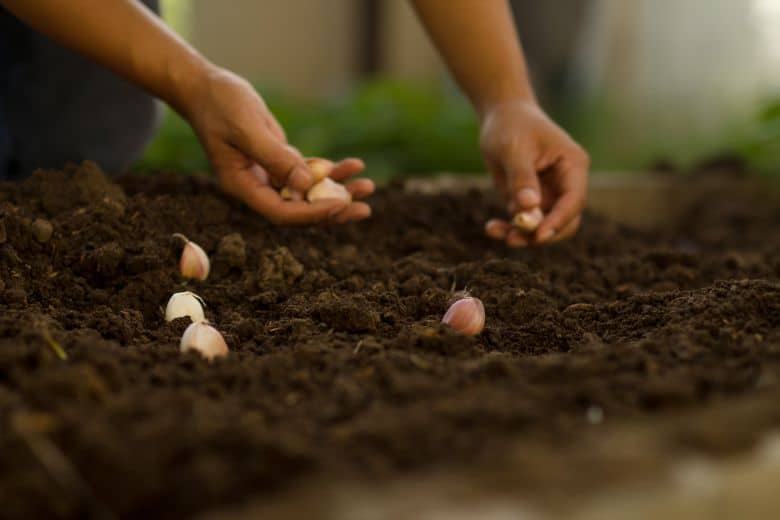
Garlic is a popular vegetable to plant in North Texas due to its ability to tolerate heat and drought. Planting garlic in North Texas should be done in the late fall or early winter months to give the plants plenty of time to establish roots before the summer heat.
The best time to plant garlic in North Texas is from October to December, depending on the variety. Garlic needs to be planted in a sunny spot with well-draining soil and should be fertilized regularly with a balanced fertilizer.
Planting garlic in North Texas at the right time will ensure a successful harvest and provide you with a delicious crop of garlic cloves.
Overview of North Texas Climate
North Texas, often referred to as the North Central Texas region, experiences a humid subtropical climate. This means the region undergoes hot, humid summers and generally mild winters with periodic cold spells.
Summer: From late May through September, North Texas temperatures can reach highs well into the 90s and occasionally surpass 100 degrees Fahrenheit. These months are typically characterized by high humidity, making the perceived heat even more intense. Rainfall during the summer is relatively sporadic but can often come in the form of severe thunderstorms, especially in the earlier months of the season.
Fall: October and November mark a transition period in North Texas, with temperatures gradually decreasing from the summer heat. While still generally warm, rainfall becomes more frequent during this period, offering much-needed hydration to the region’s plants and wildlife.
Winter: Winters in North Texas, which span from December through February, are typically mild with average highs in the 50s to 60s degrees Fahrenheit, but cold spells can occasionally drop temperatures below freezing. While snow is rare, it does occur, and ice storms are a more common winter weather event.
Spring: Spring in North Texas, from March to May, sees an increase in temperatures and rainfall. This season is particularly noted for severe weather, including thunderstorms and the possibility of tornadoes. Despite the occasional severe weather, the spring season also brings with it beautiful wildflower blooms throughout the region.
In terms of gardening and agriculture, North Texas’ climate poses certain challenges due to its heat, occasional extreme weather events, and periods of drought. However, with an understanding of these conditions and thoughtful planning, gardening can certainly thrive in this region.
Ideal Timing for Planting Garlic
The ideal timing for planting garlic is in the fall. Planting garlic in the fall allows the cloves to establish a strong root system in the cooler months, while the soil is still warm enough for the cloves to germinate.
Planted in the fall, the garlic will benefit from the cold winter temperatures, and the cloves will be ready to harvest in the late spring or early summer, depending on the variety.
The fall season offers the perfect environment for the garlic cloves to grow and develop into a full-fledged bulb; the cold winter months will ensure that the cloves are well-rooted and ready to harvest come spring.
Planting garlic in the fall is the ideal timing for a successful harvest.
Preparing the Soil for Planting
Follow these soil preparation steps for a successful garlic planting:
- Assess Your Soil: Garlic prefers fertile, well-drained soil. Heavy clay or overly sandy soils are not ideal.
- Amend as Needed: If your soil is heavy clay, improve its structure by adding compost and well-rotted manure. In sandy soils, add organic matter to increase the soil’s water-holding capacity and fertility.
- Ensure Optimal pH: Garlic prefers a pH between 6.0 and 7.0. If your soil is too acidic or alkaline, amend it accordingly.
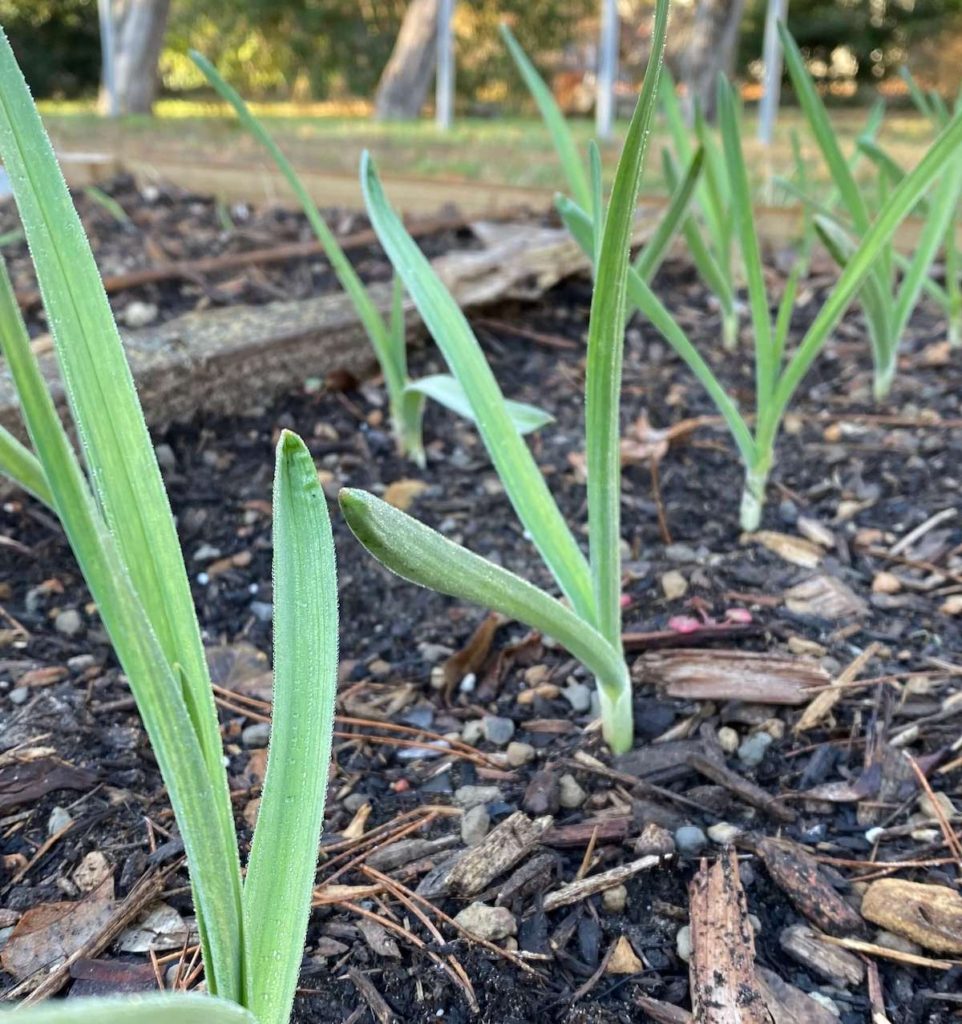
Planting Garlic Cloves in North Texas: A Step-By-Step Guide
Follow this comprehensive guide for planting garlic in North Texas to make sure your crop reaches its full potential.
Step 1: Choose the Right Garlic
Soft neck varieties of garlic are generally best suited to the warmer climates of North Texas due to their heat tolerance and longer storage life. Visit a local nursery or seed provider to purchase garlic bulbs for planting.
Step 2: Prepare the Soil
Garlic grows best in well-drained, fertile soil. Enhance the soil with organic matter or well-rotted compost, ensuring the ground is loose and crumbly. Garlic prefers slightly acidic to neutral pH levels (6.0-7.0), so consider getting a soil test and amend the soil as needed.
Step 3: Separate the Bulbs
Separate the individual cloves from the garlic bulb, being careful not to damage the base of the cloves, where the roots form. Remember, larger cloves typically yield larger bulbs.
Step 4: Plant the Cloves
Plant the garlic cloves with the pointed end facing up. Each clove should be planted about 2 inches deep, and cloves should be spaced 4-6 inches apart. Rows should be 12-18 inches apart to give each plant ample room to grow.
Step 5: Watering
Once you have planted the cloves, water the area thoroughly. Garlic requires consistent watering to grow well, but avoid overwatering as it can lead to fungal diseases and rotting.
Step 6: Apply Mulch
After planting, apply a 2-3 inch layer of mulch over the area. Straw or leaf mulch works well to keep the soil cool, suppress weeds, and conserve moisture.
Step 7: Overwintering
In North Texas, garlic is planted in the fall and overwinters in the ground. Don’t worry if you see green shoots during warm spells in winter; garlic will go back into dormancy when the temperature drops and resume growth in the spring.
Step 8: Spring Care
As the weather warms, make sure your garlic gets enough water and the soil remains weed-free. Stop watering once the lower leaves start to yellow, usually a few weeks before harvest.
Step 9: Harvesting
Garlic is typically ready to harvest in late spring or early summer when the bottom 2/3 of the leaves have turned yellow. Carefully dig up the bulbs, being careful not to damage them.
Step 10: Curing and Storing
After harvesting, cure the garlic by hanging it in a dry, well-ventilated area out of direct sunlight for a few weeks. Once the outer skin is papery, the garlic is ready to be stored in a cool, dry place until use.
Note: Don’t be discouraged if your first crop doesn’t turn out as expected. Learn from each growing season and apply your newfound knowledge to future plantings. Happy gardening!
Harvesting and Storing Garlic: A Comprehensive Guide
Knowing when and how to harvest garlic is crucial to the end quality of your crop. Here’s a step-by-step guide to help you through the process:
Harvesting Garlic
- Identify the Right Time: Garlic is generally ready for harvesting when most of the lower leaves have turned brown. In North Texas, this typically happens in late spring or early summer. Each brown leaf on the plant represents a papery layer wrapping the bulb, which is essential for long-term storage.
- Test Dig: To confirm if your garlic is ready for harvesting, carefully dig up a few bulbs from different areas of your plot. The cloves should fill out the skins, and the bulbs should be firm and well-formed.
- Dig, Don’t Pull: When the time is right, gently loosen the soil around each bulb with a trowel or a garden fork, being careful not to damage the bulbs. Avoid pulling the garlic out by the stem as it may lead to damage and affect storage life.
- Handle with Care: Freshly dug garlic is delicate and can bruise easily, which might lead to decay during storage. Handle the bulbs with care during and after harvesting.
Storing Garlic
After harvesting, your garlic needs to go through a curing process before it is ready for storage.
- Cure the Garlic: Curing involves drying the garlic bulbs to prepare them for storage. To cure garlic, tie the stalks in bundles and hang them, or lay them out in a well-ventilated area away from direct sunlight. This process usually takes about 3-4 weeks.
- Clean and Trim: Once your garlic is cured, gently brush off any soil from the bulbs. Trim off the roots, and if you prefer, you can also trim back the stalks.
- Inspect: Look over your bulbs and set aside any with damage or disease for immediate use. Only flawless, unbroken bulbs should be saved for long-term storage.
- Store Properly: Store your cured garlic in a cool, dry, well-ventilated area. Avoid storing in a refrigerator as the humidity can lead to sprouting. Mesh bags, baskets, or even paper bags can work well for storage.
- Check Regularly: Monitor your stored garlic regularly for any signs of sprouting or rotting. If a bulb starts to sprout, use it immediately.
Proper harvesting and storage methods are key to enjoying your homegrown garlic for months after harvesting. With these tips, you’ll be well on your way to a successful garlic crop year after year.
Proper Care of Planted Garlic
When it comes to planting garlic, proper care is essential in order to ensure a successful harvest. The first step in proper care of garlic is to select a well draining soil that has plenty of organic matter.
Make sure to plant the cloves with the pointy end up and cover them with 2-3 inches of soil. It is important to keep the soil moist, but not soggy, and fertilize regularly.
Garlic also requires full sun and good air circulation to thrive. To ensure the health of the plants, it is important to weed regularly and to keep an eye out for pests or disease.
Additionally, when the garlic is ready to harvest, take care when removing it from the ground to avoid damaging the bulb.
With proper care, planted garlic can provide delicious bulbs and cloves to enjoy all season long.
FAQs About the When To Plant Garlic In North Texas
What is the best time to plant garlic in North Texas?
Answer: Generally, garlic should be planted in North Texas in late October or early November, when the soil temperature is between 55-60°F.
What are the ideal soil conditions for planting garlic in North Texas?
Answer: Garlic prefers well-drained and loose soil with a pH of 6.5-7.0. The soil should be rich in organic matter, such as compost or aged manure.
How much garlic should be planted in North Texas?
Answer: Generally, it is recommended to plant around 1/2 to 1 pound of garlic cloves per 100 square feet.
Can I grow garlic bought from a grocery store?
Answer: It’s possible, but disease resistance and local adaptability might be compromised. Buying from a reputable nursery or seed catalog is recommended.
Conclusion
In conclusion, planting garlic in North Texas is best done in the fall. Planting garlic in the fall gives the bulbs time to establish themselves before summer and the hot temperatures arrive. Planting garlic in North Texas is an easy way to add flavor to your meals and the garlic can last for up to 8 months when stored correctly. With the right preparation, North Texas gardeners can enjoy a tasty harvest of garlic for months to come.

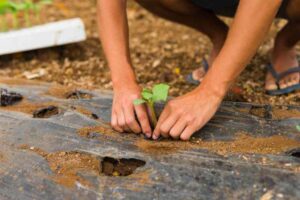
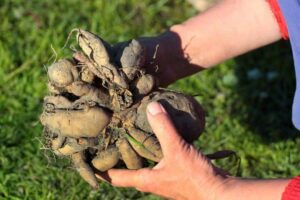
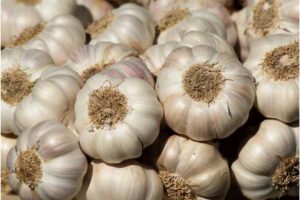
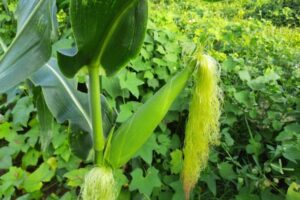
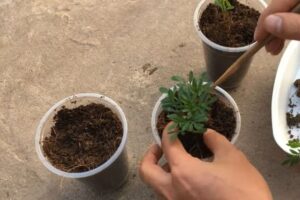
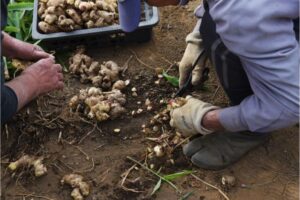
One Comment